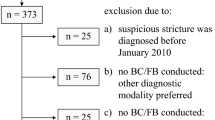Abstract
Background/purpose
In patients in whom there is a suspicion of malignant biliary strictures, bile cytology via an endoscopic nasobiliary drainage tube (ENBD cytology) is often performed, in addition to aspirated bile cytology, brush cytology, and forceps biopsy, during the initial endoscopic retrograde cholangiopancreatography (ERCP). We aimed to reveal the significance of ENBD cytology for the pathological diagnosis of malignant biliary strictures.
Methods
We studied 214 patients with malignant biliary strictures. We performed aspirated bile cytology, brush cytology, and forceps biopsy in 93, 130, and 114 patients, respectively. ENBD cytology was performed one or more times in 79 patients. We examined the sensitivity of each sampling method, and analyzed the utility of ENBD cytology.
Results
The sensitivities of each sample acquisition method were as follows: 30% (28/93) for aspirated bile cytology, 48% (62/130) for brush cytology, 41% (47/114) for forceps biopsy, and 24% (19/79) for ENBD cytology. In 19 patients who showed positive ENBD cytology, other methods were performed in 11. Aspirated bile cytology, brush cytology, and forceps biopsy, were performed in 7, 5, and 6 patients, and the results were negative in 3 (43%), 2 (40%), and 1 (17%) patient, respectively. Three patients showed positive results only on ENBD cytology.
Conclusions
Although the sensitivity of ENBD cytology was inferior to that of the other methods used, ENBD cytology may contribute to the improvement of the total diagnostic sensitivity for malignancy.

Similar content being viewed by others
References
Hirano K, Komatsu Y, Yamamoto N, Nakai Y, Sasahira N, Toda N, et al. Pancreatic mass lesions associated with raised concentration of IgG4. Am J Gastroenterol. 2004;99:2038–40.
Foutch PG, Kerr DM, Harlan JR, Kummet TD, et al. A prospective, controlled analysis of endoscopic cytotechniques for diagnosis of malignant biliary strictures. Am J Gastroenterol. 1991;86:577–80.
Davidson B, Varsamidakis N, Dooley J, Deery A, Dick R, Kurzawinski T, et al. Value of exfoliative cytology for investigating bile duct strictures. Gut. 1992;33:1408–11.
Mansfield JC, Griffin SM, Wadebra V, Matthewson K, et al. A prospective evaluation of cytology from biliary strictures. Gut. 1997;49:671–7.
Sugiyama M, Atomi Y, Wada N, Kuroda A, Muto T, et al. Endoscopic transpapillary bile duct biopsy without sphincterotomy for diagnosing biliary strictures: a prospective comparative study with bile and brush cytology. Am J Gastroenterol. 1996;91:465–7.
Schoefl R, Haefner M, Wrba F, Pfeffel F, Stain C, Poetzi R, et al. Forceps biopsy and brush cytology during endoscopic retrograde cholangiopancreatography for the diagnosis of biliary stenoses. Scand J Gastroenterol. 1997;32:363–8.
Jailwala J, Fogel EL, Sherman S, Gottlieb K, Flueckiger J, Bucksot LG, et al. Triple-tissue sampling at ERCP in malignant biliary obstruction. Gastrointest Endosc. 2000;51:383–90.
Ponchon T, Gagnon P, Berger F, Labadie M, Liaras A, Chavaillon A, et al. Value of endobiliary brush cytology and biopsies for the diagnosis of malignant bile duct stenosis: results of a prospective study. Gastrointest Endosc. 1995;42:565–72.
Kubota Y, Takaoka M, Tani K, Ogura M, Kin H, Fujimura K, et al. Endoscopic transpapillary biopsy for diagnosis of patients with pancreaticobiliary ductal strictures. Am J Gastroenterol. 1993;88:1700–4.
Tamada K, Tomiyama T, Wada S, Ohashi A, Satoh Y, Ido K, et al. Endoscopic transpapillary bile duct biopsy with the combination of intraductal ultrasonography in the diagnosis of biliary strictures. Gut. 2002;50:326–31.
Uchida N, Kamada H, Ono M, Aritomo Y, Masaki T, Nakatsu T, et al. How many cytological examinations should be performed for the diagnosis of malignant biliary stricture via an endoscopic nasobiliary drainage tube? J Gastroenterol Hepatol. 2008;23:1501–4.
Vandervoort J, Soetikno RM, Montes H, Lichtenstein DR, Van Dam J, Ruymann FW, et al. Accuracy and complication rate of brush cytology from bile duct versus pancreatic duct. Gastrointest Endosc. 1999;49:322–7.
Lee DW, Chan AC, Lam YH, Ng EK, Lau JY, Law BK, et al. Biliary decompression by nasobiliary catheter or biliary stent in acute suppurative cholangitis: a prospective randomized trial. Gastrointest Endosc. 2002;56:361–5.
Sharma BC, Kumar R, Agarwal N, Sarin SK, et al. Endoscopic biliary drainage by nasobiliary drain or by stent placement in patients with acute cholangitis. Endoscopy. 2005;37:439–43.
Author information
Authors and Affiliations
Corresponding author
About this article
Cite this article
Yagioka, H., Hirano, K., Isayama, H. et al. Clinical significance of bile cytology via an endoscopic nasobiliary drainage tube for pathological diagnosis of malignant biliary strictures. J Hepatobiliary Pancreat Sci 18, 211–215 (2011). https://doi.org/10.1007/s00534-010-0333-x
Published:
Issue Date:
DOI: https://doi.org/10.1007/s00534-010-0333-x




